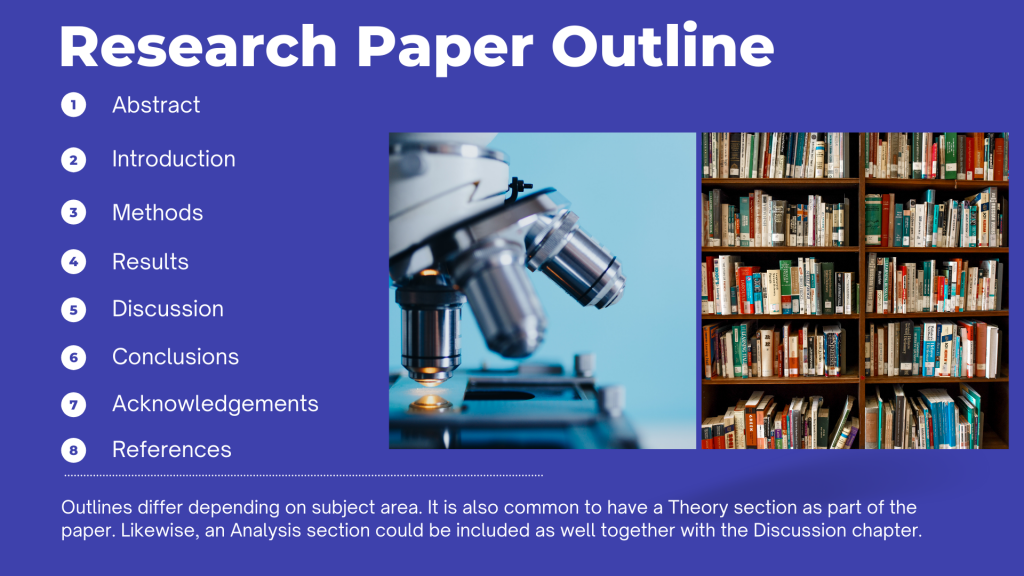In a research paper, an outline is a logical itemization of all the contents of the paper e.g., major headings, subheadings, and other necessary additions. Most times, outlines are formally determined by the recipients of the research paper, for example, a university or a peer-reviewed journal. Formal outlines are an educational necessity because, without them, research papers will lack a standard format or order, meaning that each author may write in whatever format he or she desires.
This paper takes a look at the common outlines for an academic paper as well as a thesis. Please note that the outline varies depending on research area, institution, journal etc so it’s always best to conform to the outline specified by the publishing outlet for your study.
Typical journal paper outline

Abstract
A summary or overview of the article. The main additions here are the research methods, findings, conclusion, and recommendations.
Introduction
The introduction offers a brief overview of the topic under investigation. It tries to explain the important variables, concepts, etc surrounding the topic so as to shed more light and provide the necessary background for the research problem and the paper as a whole.
Methods
The methods section tries to describe all the constituents of the research design as a whole. It captures those techniques or procedures which the researcher has deployed to answer the research questions and resolve the hypothesis. The section explains the procedures used to collect data as well as the techniques for data analysis, among others.
Results
In this section, the results of all the methods used to empirically measure the variables, test the hypothesis, etc are presented in a coherent and logical manner. Some journals may insist that computer printouts from measurement software be included for clarity.
Discussion
This is where the researcher uses his or her data analysis results to discuss whether the study solved the problem it intended to solve and/or closed the knowledge gap it intended to close, among other relevant discussions. The researcher should clearly show that he or she has identified and understood the trends, patterns, and themes within his or her data. The study’s conclusions and recommendations are heavily influenced by the discussion of findings.
Conclusion
The study’s conclusion(s), inspired mostly by the empirical findings from the measured data. Writers usually make recommendations after concluding. They can also offer suggestions for further research.
Acknowledgements
This segment is meant to appreciate or say thank you to all those that helped in the actualization of the article.
References
An alphabetical ordering or listing of all the sources cited in the article. It is usually determined by the Style Guide provided by the journal’s editorial team.
Typical thesis outline
Cover page
The cover page should start with the topic of the thesis, name and matriculation number (if relevant), the destination and purpose of the thesis [e.g., a thesis submitted to the department of economics in partial fulfillment of the requirements for the award of a doctor of philosophy (Ph.D.) degree in economics] as well as the submission date which is located towards the bottom of the page. The cover page is usually not numbered
Title page
Has the same contents as the cover page but is numbered (from the title page to the glossary of foreign words page are numbered in Roman numerals)
Certification page
At some universities, the student is certified as having personally conducted the study by the Faculty Dean, Head of Department, and external examiner
Dedication page
A page where you dedicate your study to those he or she deems appropriate
Acknowledgment page
The student expresses gratitude to those who assisted in one way or another during the course of writing the thesis.
- Abstract page
A brief (not more than a page) summary or overview of the thesis, especially the research methodology, findings, conclusion, and recommendations.
- Table of contents
A table showing all the major headings in the thesis and the page numbers where they are located.
- List of tables
A list of all the tables used in the study including their label numbers and the page numbers where they are located.
- List of figures
A list of all the figures used in the study including their label numbers and the page numbers where they are located.
Abbreviations of references
An alphabetical ordering of all abbreviations used in the references.
- Glossary of foreign words
An expression and translation of all foreign words, phrases, and sentences used in the thesis.
CHAPTER ONE
INTRODUCTION
- Background of the study
This is a brief overview of the topic under investigation. It tries to discuss the key variables, concepts, etc underlying the topic with a view to providing insight and laying the necessary foundation for the research problem and the rest of the thesis.
- Statement of the problem
This is one of the most important segments of the thesis. The author has to present the problem that prompted the study convincingly. This means that readers should not be in doubt as to the need for the study after perusing the problem statement.
- Objectives of the study
Every study must have at least one purpose or objective it intends to achieve. This section of the chapter is meant for the author to enumerate the objectives of his study. They are usually expressed in bullet points.
- Research questions
These are pertinent questions formulated by the researcher to help find solutions to the stated research problems. They should be carefully framed according to the study’s objectives and problem statement.
- Research hypothesis
A conjecturing of possible relationships among the key variables under investigation. The hypothesis is subsequently tested with an appropriate technique from the research methodology/design.
- Significance of the study
Here, you try to justify the importance or relevance of your research in terms of its overall usefulness to the academic community and society as a whole.
- Scope of the study
This is a brief explanation of the areas the research intends to focus on. It is mainly determined by the topic and problem.
- Limitations of the study
All studies are faced with one limitation or another. This could be inadequate funding, scarcity of data, time constraints, etc. In this segment, you state whatever constraints you faced while conducting the research.
CHAPTER TWO
LITERATURE REVIEW
Brief introduction of the chapter’s contents.
Conceptual review of literature
Definition/description of the various key concepts, variables, etc that relate to the topic research problem, questions, and hypothesis.
Theoretical review of literature
Review of various theories that shed light on the topic under investigation. Care must be taken to include only topics that are relevant to the study.
Empirical review of literature
A report of some previous empirical findings related to the topic of interest. The author should endeavor to present a balanced report by reporting contrasting findings or results.
Literature gap
Usually, researchers are not only expected to identify gaps in knowledge through their research but also to clearly describe how they will fill such gaps. The researcher is expected to state the observed gaps in this section as well as how he or she will fill them.
CHAPTER THREE
RESEARCH METHODOLOGY
Brief introduction of the chapter’s contents.
Research design
The researcher explains the design he or she has adopted for his or her research as well as the rationale for choosing such a design.
Sources of data
In this section, you clearly disclose all the sources from which you have collected data for the research.
Data analysis techniques
Most researches require a combination of various measurement techniques or approaches. You can enumerate all of them in this segment.
Model specification
For those that have opted for regression analysis (such as OLS, VAR, etc), it is very important to specify a model for your dependent and independent variables.
Tests of hypothesis and significance
This is the section where you have to describe the various hypotheses testing techniques you used in detail. Be sure to include equations, formulas, and mathematical symbols/notations.
CHAPTER FOUR
PRESENTATION AND ANALYSIS OF DATA
Brief introduction of the chapter’s contents
Data presentation
To ensure validity and reliability, the data used to generate empirical results or findings should be presented in this section. They are usually arranged in a tabular format.
Analysis of data and hypothesis tests
A detailed analysis of collected data. Usually commences with descriptive analysis. Results of the hypothesis tests are also analyzed in this segment. Tables and other diagrams should help support verbal analysis. If the tables were generated by software, the software used and its version must be indicated underneath the tables and other diagrams.
Estimation results
This section is reserved for the results from regression estimates as well as some of the measures of validity and reliability (such as multicollinearity, autocorrelation, homoskedasticity, etc). Results from causality tests and other estimations can also be included here. Tables and other diagrams (e.g., computer printouts) are also necessary for this segment.
Discussion of findings
In this section, the researcher is expected to report on the data he or she has collected, processed, and analyzed. He or she has an opportunity to use the discussion to justify his investigation and also to show his logical reasoning capabilities. You should try to state the theoretical and practical implications of your studies. You should also compare your findings with those of others.
CHAPTER FIVE
SUMMARY, CONCLUSION, AND RECOMMENDATIONS
Summary of findings
A brief rehash of the key findings of the study.
Conclusion
The study’s conclusion(s) based on the empirical findings from the measured data.
Recommendations
Potential policy (and other) recommendations based on the study’s findings.
Suggestions for further research
Based on his or her observations while conducting the research, the researcher suggests possible directions or areas that should be researched in future.
Contributions to knowledge
In this section, you are expected to clearly explain what your study has contributed to the body of knowledge in your field of learning.
References
An alphabetical ordering or listing of all the sources cited in the thesis. This is written according to the Style Guide approved by the faculty or department.
Appendices
An arrangement of all diagrams or illustrations that may provide useful insight (mostly empirical insight) but may not be ideal to be included in the main body of the thesis. These include tables, graphs, charts, and others. Ensure that you place only one diagram per page and that each diagram must be numbered, e.g., Appendix 1, Appendix 2, etc.


